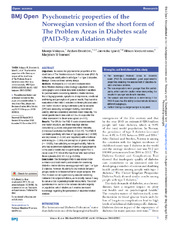| dc.contributor.author | Vislapuu, Maarja | en_US |
| dc.contributor.author | Brostrøm, Anders | en_US |
| dc.contributor.author | Igland, Jannicke | en_US |
| dc.contributor.author | Vorderstrasse, Allison | en_US |
| dc.contributor.author | Iversen, Marjolein M. | en_US |
| dc.date.accessioned | 2019-12-19T11:58:23Z | |
| dc.date.available | 2019-12-19T11:58:23Z | |
| dc.date.issued | 2019 | |
| dc.Published | Vislapuu M, Brostrøm A, Igland J, Vorderstrasse, Iversen M.M.. Psychometric properties of the Norwegian version of the short form of the Problem Areas in Diabetes scale (PAID-5): A validation study. BMJ Open. 2019;9:e022903 | eng |
| dc.identifier.issn | 2044-6055 | |
| dc.identifier.uri | https://hdl.handle.net/1956/21189 | |
| dc.description.abstract | Objectives To assess the psychometric properties of the short form of The Problem Areas in Diabetes scale (PAID-5) in Norwegian adult patients with type 1 or type 2 diabetes. Design Cross-sectional survey design. Methods Participants (n=143) were included from three Western-Norway endocrinology outpatient clinics. Demographic and clinical data were collected in addition to questionnaires concerning diabetes-related distress, fear of hypoglycaemia, symptoms of depression, emotional well-being and perception of general health. Psychometric evaluation of the PAID-5 included confirming its postulated one-factor structure using confirmatory factor analysis (CFA) and assessing convergent validity, discriminant validity, internal consistency and test-retest reliability. The retest questionnaire was sent out 35±15 days after the initial assessment to those who agreed (n=117). Results The CFA for the PAID-5 scale showed excellent one-factor structure, and there was high internal consistency (α=0.89) and good test-retest reliability (Intraclass Correlation Coefficient, ICC=0.81). The PAID-5 correlated positively with fear of hypoglycaemia (r=0.598) and depression (r=0.380) and negatively with emotional well-being (r=−0.363) and perception of general health (r=−0.420), thus satisfying convergent validity. Patients who had experienced episodes of serious hypoglycaemia in the past 6 months had a significantly higher PAID-5 mean score (7.5, SD=4.95) than those who had not had these episodes (5.0, SD=4.2 (p=0.043)). Conclusion The Norwegian PAID-5 was shown to be a reliable and valid short questionnaire for assessing diabetes-related distress among people with type 1 or type 2 diabetes. However, its ability to discriminate between groups needs to be tested further in larger samples. The PAID-5 scale can be a particularly valuable screening instrument in outpatient clinics, as its brevity makes it easy to use as a tool in patient-provider encounters. This short questionnaire is useful in the national diabetes registry or population cohort studies as it enables increased knowledge regarding the prevalence of diabetes-related distress. | en_US |
| dc.language.iso | eng | eng |
| dc.publisher | BMJ | eng |
| dc.rights | Attribution CC BY-NC | eng |
| dc.rights.uri | http://creativecommons.org/licenses/by-nc/4.0/ | eng |
| dc.title | Psychometric properties of the Norwegian version of the short form of the Problem Areas in Diabetes scale (PAID-5): A validation study | en_US |
| dc.type | Peer reviewed | |
| dc.type | Journal article | |
| dc.date.updated | 2019-08-15T12:29:40Z | |
| dc.description.version | publishedVersion | en_US |
| dc.rights.holder | Copyright 2019 The Author(s) | |
| dc.identifier.doi | https://doi.org/10.1136/bmjopen-2018-022903 | |
| dc.identifier.cristin | 1705427 | |
| dc.source.journal | BMJ Open | |

